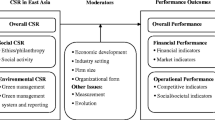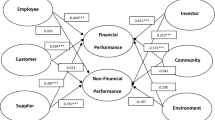Abstract
Corporate social responsibility (CSR) is rarely incorporated into best practice selection, despite the fact that most large multi-national corporations receive heavy pressure from stakeholders to engage in CSR. In contrast with CSR, profitability is always recognized as a major element when selecting best practices (or best firms). Without incorporating CSR into best practice selection, firms with high profitability but low CSR can be identified as best practices. If requested to emulate high-profitability yet low-CSR ‘best practices’ to improve the organizational performance, firms may increase profitability but also lower their social responsibility, eventually causing an abnormality. Data envelopment analysis (DEA) is a powerful benchmarking tool for situations where multiple inputs and outputs need to be assessed to identify best practices and improve productivity in firms. However, simply adding the CSR measure to DEA outputs does not change the selection of best firms. Specifically, when CSR and profitability measures are pooled as DEA outputs, the conventional DEA identifies the firms with low CSR as best practices. To overcome this drawback, a new benchmarking method is proposed to select best practices with an integrated perspective of CSR and profitability. The proposed method is applied to an empirical case including 66 large firms in Taiwan and opens up a new path for future benchmarking research.





Similar content being viewed by others
Notes
This study does not assume any special relationship between CSR and profitability beforehand. The point emphasized here is that firms with high profitability but low CSR should not be recognized as best practices. Otherwise, firms will likely favor profitability over CSR, creating a norm that disfavors CSR efforts.
References
Banker, R.D., Charnes, A., Coope, W.W.: Some models for estimating technical and scale inefficiencies in data envelopment analysis. Manage. Sci. 30(9), 1078–1092 (1984)
Barnett, M.L., Salomon, R.M.: Beyond dichotomy: the curvilinear relationship between social responsibility and financial performance. Strategic Manage. J. 27(11), 1101–1156 (2006)
Becchetti, L., Trovato, G.: Corporate social responsibility and firm efficiency: a latent class stochastic frontier analysis. J. Prod. Anal. 36(3), 231–246 (2011)
Belu, C.: Ranking corporations based on sustainable and socially responsible practices: a data envelopment analysis (DEA) approach. Sustain. Dev. 17(4), 257–268 (2009)
Beurden, P., Gössling, T.: The worth of values: a literature review on the relation between corporate social and financial performance. J. Bus. Ethics 82(2), 407–424 (2008)
Bowen, H.R.: Social Responsibilities of the Businessman. Harper & Brothers, New York (1953)
Bowman, E.H., Haire, M.: A strategic posture toward corporate social responsibility. Calif. Manage. Rev. 18(2), 49–58 (1975)
Camanho, A.S., Dyson, R.G.: Efficiency, size, benchmarks and targets for bank branches: an application of data envelopment analysis. J. Oper. Res. Soc. 50(9), 903–915 (1999)
Carroll, A.B.: A three-dimensional conceptual model of corporate performance. Acad. Manage. Rev. 4(4), 497–505 (1979)
Chang, D.S., Yang, F.C.: A new benchmarking method to advance the two-model DEA approach: evidence from a nursing home application. INFOR 48(2), 83–94 (2010)
Charnes, A., Cooper, W.W., Rhodes, E.: Measuring the efficiency of decision making units. Eur. J. Oper. Res. 2(6), 429–444 (1978)
Charnes, A., Cooper, W.W., Huang, Z.M., Wei, Q.L.: Cone ratio data envelopment analysis and multi-objective programming. Int. J. Syst. Sci. 20(7), 1099–1118 (1989)
Chen, C.M., Delmas, M.A.: Measuring corporate social performance: an efficiency perspective. Prod. Oper. Manag. 20(6), 789–804 (2011)
Cook, W.D., Seiford, L.M.: Data envelopment analysis (DEA)-thirty years on. Eur. J. Oper. Res. 192(1), 1–17 (2009)
Cooper, W., Seiford, L., Tone, K.: Data Envelopment Analysis: A Comprehensive Text with Models, Applications, References and DEA-solver Software. Springer, New York (2006)
Davis, K.: Can business afford to ignore social responsibilities? Calif. Manage. Rev. 2, 70–76 (1960)
Delmas, M.A., Toffel, M.: Organizational responses to environmental demands: opening the black box. Strategic Manage. J. 29(10), 1027–1055 (2008)
Deresky, H.: International Management. Prentice Hall, Upper Saddle River (2003)
Hillman, A., Keim, G.: Shareholder value, stakeholder management, and social issues: what’s the bottom line? Strategic Manage. J. 22(2), 125–139 (2001)
Kang, H.H., Liu, S.B.: Corporate social responsibility and corporate performance: a quantile regression approach. Qual. Quant. 48(6), 3311–3325 (2014)
Liu, J.S., Lu, L.Y.Y., Lu, W.M., Lin, B.J.Y.: A survey of DEA applications. Omega 41(5), 893–902 (2013)
Loureiro, M.L., Lotade, J.: Do fair trade and eco-labels in coffee wake up the consumer conscience? Ecol. Econ. 53(1), 129–138 (2005)
Lu, L.Y.Y., Liu, J.S.: The knowledge diffusion paths of corporate social responsibility-from 1970 to 2011. Corp. Soc. Responsib. Environ. Manag. 21(2), 113–128 (2014)
Paul, C.J.M., Siegel, D.S.: Corporate social responsibility and economic performance. J. Prod. Anal. 26(3), 207–211 (2006)
Ruf, B., Muralidhar, K., Paul, K.: The development of a systematic, aggregate measure of corporate social performance. J. Manag. 24(1), 119–133 (1998)
Seiford, L.M.: Data envelopment analysis: the evolution of the state of the art (1978–1995). J. Prod. Anal. 7(2), 99–137 (1996)
Seiford, L.M., Zhu, J.: Modeling undesirable factors in efficiency evaluation. Eur. J. Oper. Res. 142(1), 16–20 (2002)
Seiford, L.M., Zhu, J.: Context-dependent data envelopment analysis: measuring attractiveness and progress. Omega 31(5), 397–408 (2003)
Sherman, H.D., Zhu, J.: Benchmarking with quality-adjusted DEA (Q-DEA) to seek lower-cost high-quality service: evidence from a U.S. bank application. Ann. Oper. Res. 145(1), 301–319 (2006)
Shimshak, D.G., Lenard, M.L.: A two-model approach to measuring operating and quality efficiency with DEA. INFOR 45(3), 143–151 (2007)
Shimshak, D.G., Lenard, M.L., Klimberg, R.K.: Incorporating quality into data envelopment analysis of nursing home performance: a case study. Omega 37(3), 672–685 (2009)
Thompson, R.G., Singleton, F.D., Thrall, R.M., Smith, B.A.: Comparative site evaluations for locating a high-energy physics lab in Texas. Interfaces 16(6), 35–49 (1986)
Waddock, S., Graves, S.: The corporate social performance-financial performance link. Strategic Manage. J. 18(4), 303–319 (1997)
Wood, D.J.: Corporate social performance revisited. Acad. Manag. Rev. 16(4), 691–718 (1991)
Author information
Authors and Affiliations
Corresponding author
Appendices
Appendix A: conventional DEA model
Consider a group of n firms, with each firm j (j = 1, …, n), using m inputs x ij (i = 1, …, m) and producing s outputs y rj (r = 1, …, s). Model (1) shows the input-oriented DEA with the constant returns to scale (CRS) assumption (Charnes et al. 1978).
subject to
where \(s_{i}^{ - }\) is the input excess of i-th input and \(s_{r}^{ + }\) is the output shortfall of r-th output. The efficiency score θ * is expressed as a number between 0 and 1. An evaluated firm with an efficiency score equal to 1 is deemed efficient relative to other firms. The reference set for an inefficient firm k is defines as E k . E k = {j|λ k j > 0} (j ∈ {1, …, n}). An optimal solution can be expressed as \(\theta^{*} x_{k} = \sum\nolimits_{{j \in E_{k} }} {x_{j} \lambda_{j}^{*} + s^{{ -^{*} }} }\) and \(y_{k} = \sum\nolimits_{{j \in E_{k} }} {y_{j} \lambda_{j}^{*} - s^{{ +^{*} }} }\). These can be further interpreted as \(x_{k} \ge \theta^{*} x_{k} - s^{{ -^{*} }} = \sum\nolimits_{{j \in E_{k} }} {x_{j} \lambda_{j}^{*} }\) and \(y_{k} \le y_{k} + s^{{ +^{*} }} = \sum\nolimits_{{j \in E_{k} }} {y_{j} \lambda_{j}^{*} }\). These relations suggest that the efficiency of (x k , y k ) for firm k can be improved if the input values are reduced radially by the ration θ* and the input excesses recorded in \(s^{{ -^{*} }}\) are eliminated. Similarly efficiency can be attained if the output values are augmented by the output shortfalls in \(s^{{ +^{*} }}\).
Appendix B: stratification DEA model
Assume that there are n firms which produce s outputs by using m inputs. The set of all firms is defined as J 1 and the set of efficient firms in J 1 is defined as E 1. Then the sequences of J z and E z are defined recursively as J z+1 = J z − E z. Model (2) presents the stratification DEA model with the input-oriented CRS assumption (Seiford and Zhu 2003).
subject to
x ij and y rj are i-th input and r-th output of firm k. When z = 1, Model (2) becomes Model (1).
Rights and permissions
About this article
Cite this article
Yang, FC. Integrating corporate social responsibility and profitability into best practice selection: the case of large Taiwanese firms. Qual Quant 51, 1493–1512 (2017). https://doi.org/10.1007/s11135-016-0348-8
Published:
Issue Date:
DOI: https://doi.org/10.1007/s11135-016-0348-8




